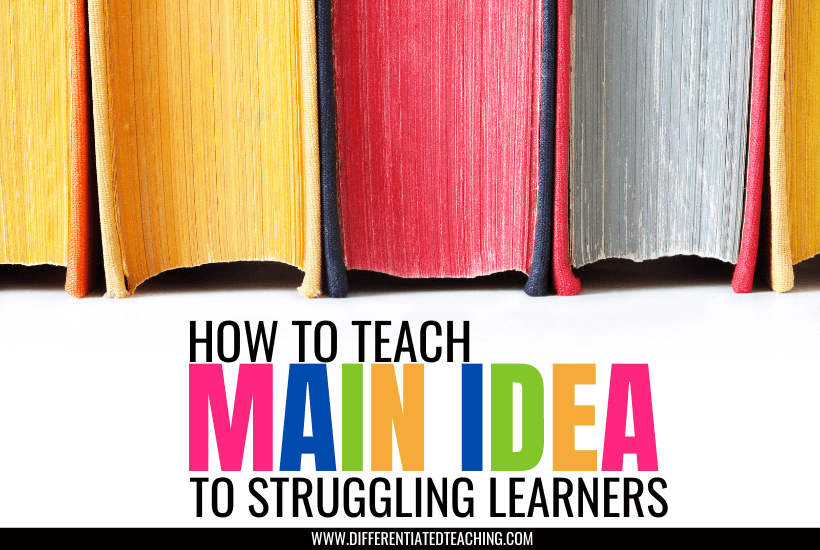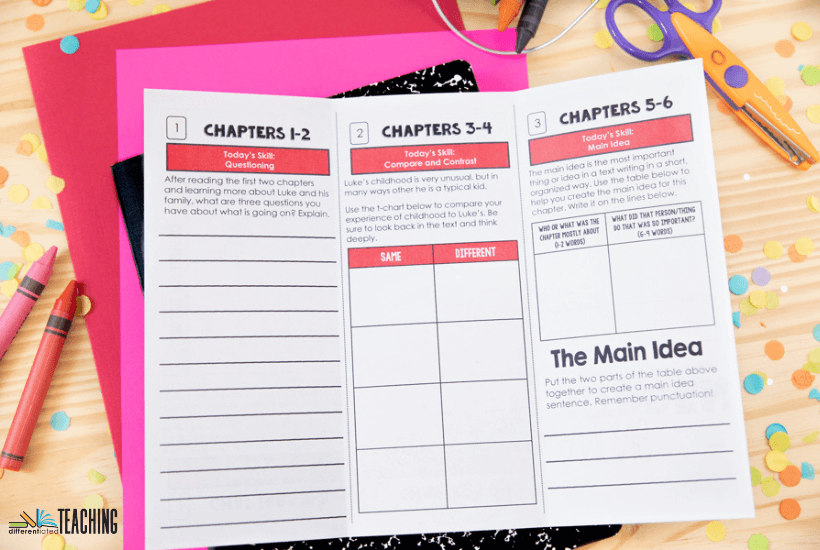4 Ways to Teach Main Idea with Struggling Learners in Mind
If you’ve been teaching for any length of time, you already know that one of the most important (and most challenging) skills you teach year is identifying the main idea of a text. The main idea is the “big idea” the author is trying to communicate. It is a concise statement that captures the point of the piece. However, getting there requires some serious higher-level thinking skills. Not only do your students need to be able to read and comprehend the text, but they also need to analyze the information to identify the most important details.

Teaching main idea can be tough, but it is so important. Helping your students learn how to identify the main idea is essential for their success in reading comprehension. These three strategies will help you teach your students how to identify the main idea of a text, even if they are struggling readers.
1. Teach Main Idea with Pictures
One of the best ways to introduce students to finding the main idea is with pictures. This strategy is especially effective with struggling readers and English language learners. When you use pictures to teach main idea, you are providing a concrete way for students to visualize and understand the concept without allowing decoding or basic reading comprehension skills to become a barrier to learning.
For example, you can show your students a picture of a dog and ask them what the dog is doing. Then, ask them to tell you what the picture is mostly about. Using this strategy, you can gradually introduce more complex pictures and texts until your students can identify the main idea of a written text on their own.
Give students opportunities to independently find the main idea of pictures using a Picture of the Week warm-up. Check out mine below.
2. Model and use graphic organizers to help learners visualize.
Graphic organizers are another great way to help your students learn how to identify the main idea of a text. When you model for your students how to use a graphic organizer, they clearly understand how to use these concrete tools to organize their thoughts and ideas about a text.
Start with a short selection – a paragraph from a book, an article, or even a few sentences from a longer text – and walk your students through the process of identifying the main idea. As you’re doing this, be sure to point out any clues that helped you arrive at the main idea. For example, you might say, “I noticed that all of these sentences were talking about the same thing, so I knew that must be the main idea.”
Then, give your students a chance to practice with a graphic organizer on their own. They can use the same text you used to model, or you can provide them with a different one. As they work, circulate around the room and offer help as needed.
Eventually, your students will be ready to use these same organizers to find the main idea of entire chapters or selections. The example below shows how students use a t-chart organizer to find the main idea of a chapter in the novel study Among the Hidden.

3. Use sentence starters to help learners express the main idea in their own words
One of the best ways to help your students internalize the concept of main idea is to have them express it in their own words. This strategy also helps with retention and recall, as students are more likely to remember something they have said themselves.
When you teach main idea, provide your students with a selection of sentence starters that they can use to express the main idea of a text. These sentence starters can be used with any text and provide a framework for students to express the main idea in their own words. For example, you might provide sentence starters such as:
- The most important thing to know about _____ is _____.
- _____ is _____ because _____.
- The main idea of _____ is _____.
As your students become more comfortable with this strategy, challenge them to develop their own sentence starters. This will help them internalize the concept even further.
4. Use questioning to help learners identify the main idea.
Another great way to help your students learn how to identify the main idea is to use questions. When you teach main idea, this strategy allows you to assess your students’ understanding of the concept in a low-pressure way, and it also gives them some practice in articulating the main idea of a text.
To get started, choose a short selection of text – a paragraph or two from a book or article, for example – and ask your students some questions about it. For example, you might ask:
- What is this text mostly about?
- What are the author’s main points?
- What are the most important things to know about this topic?
As your students become more comfortable with this strategy, you can gradually increase the length of the text selection. You can also ask more challenging questions, such as:
- What is the author’s purpose in writing this?
- What are the implications of this text?
- What are some alternate interpretations of this text?
Teach main idea step-by-step to support deeper understanding
When you teach main idea, it is important to break it down into a clear step-by-step process. Helping students see how they synthesize text to find the key pieces is an important part of the process. This can be as simple as finding who or what the text is mostly about and determining the most important thing. Know it will likely take students many opportunities to practice this skill before they master the concept.
These are just a few strategies that you can use to teach main idea in your classroom. Of course, there are many other effective strategies out there as well. The important thing is to find what works best for you and your students. Taking the time to help students master this important skill will serve them across many domains,
Experiment with different techniques. Ask for your students’ feedback to fine-tune your approach and ensure that everyone in your class learns this important skill!








